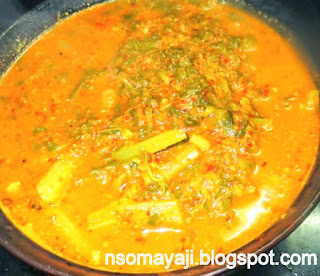Snake Gourd & Sweet Potato curry is a gravy dish and it is one of the traditional dish of Udupi. It is slightly sweet so it is called sweet curry and serving in the beginning of the lunch.
I have used Snake gourd, sweet potato, fresh coconut and red chilly for spice.
It is very easy and yummy curry and goes well with almost all the main dish.
Let us see some benefits of having " Ghee " in our diet.
Ghee helps to boost energy and reduce inflammation in the joints. It helps to reduce allergy and protect us from chronic disease. It helps in our eye health and strengthen our immune system. Ghee is rich source of good fatty acids and it is useful for the body. It is good for athletes or any other people to be active. It provides high energy. It has good amount of anti oxidant properties and helps in reducing the stress in the body. Ghee has good amount of Vitamin A, Vitamin E and Vitamin D properties. Ghee contain monounsaturated fats/Omega -3 and some fatty acids and they are good for positive health benefits to the body.
No Onion or No Garlic added in this Snake Gourd and Sweet Potato Sweet Curry.
It is called as sweet curry because little more quantity of jaggery is added than ususal to the curry and not much of spice except the red chilly which is used in seasoning.
Let us see the recipe Now :
Snake Gourd/Padavala Kai : 1 Bowl ( One small snake gourd)
Sweet Potato : 1 (medium size)
To Add :
Jaggery : 1 Tablespoons
Salt : As required
To Grind :
Fresh grated coconut : 1 Cup
Soaked Raw rice : 1 Teaspoon
To Season
Mustard seeds : 1/2 Teaspoon
Red chilly : 2
Ghee : 1 Tablespoon
Curry Leaves : 5 to 6
2. Wash and remove the outer layer of sweet potato and wash it again. Cut into small pieces.
3. Cook snake gourd pieces and sweet potatoes with little water till soft.
4. Soak raw rice for 5 minutes.
5. Grate coconut and grind it with soaked raw rice using required water. Remove from the mixi jar.
6. Keep a big pan on the fire and add cooked vegetalbes. ( Snake gourd and sweet potato pieces ).
7. Add salt and let it boil for a minute. Add ground coconut and mix it well.
8. Add jaggery and required salt. Mix it well. Let it cook for 2 to 3 minutes.
9. Shift the " Snake Gourd & Sweet Potato Sweet Curry to a serving dish.
10. Add ghee fried mustard seeds, red chilly and curry leaves seasoning to the curry and serve.
You can also try this sweet curry with watermelon rind, ridge gourd, chayote squash/seeme badane, bottle gourd and carrots.
Time : 20 Minutes
Serves : 3 to 4
Traditional South Indian Dish.
I have used Snake gourd, sweet potato, fresh coconut and red chilly for spice.
It is very easy and yummy curry and goes well with almost all the main dish.
Let us see some benefits of having " Ghee " in our diet.
Ghee helps to boost energy and reduce inflammation in the joints. It helps to reduce allergy and protect us from chronic disease. It helps in our eye health and strengthen our immune system. Ghee is rich source of good fatty acids and it is useful for the body. It is good for athletes or any other people to be active. It provides high energy. It has good amount of anti oxidant properties and helps in reducing the stress in the body. Ghee has good amount of Vitamin A, Vitamin E and Vitamin D properties. Ghee contain monounsaturated fats/Omega -3 and some fatty acids and they are good for positive health benefits to the body.
No Onion or No Garlic added in this Snake Gourd and Sweet Potato Sweet Curry.
It is called as sweet curry because little more quantity of jaggery is added than ususal to the curry and not much of spice except the red chilly which is used in seasoning.
Let us see the recipe Now :
Things Needed :
To CookSnake Gourd/Padavala Kai : 1 Bowl ( One small snake gourd)
Sweet Potato : 1 (medium size)
To Add :
Jaggery : 1 Tablespoons
Salt : As required
To Grind :
Fresh grated coconut : 1 Cup
Soaked Raw rice : 1 Teaspoon
To Season
Mustard seeds : 1/2 Teaspoon
Red chilly : 2
Ghee : 1 Tablespoon
Curry Leaves : 5 to 6
Method :
1. Wash and cut snake gourd into small pieces2. Wash and remove the outer layer of sweet potato and wash it again. Cut into small pieces.
3. Cook snake gourd pieces and sweet potatoes with little water till soft.
4. Soak raw rice for 5 minutes.
5. Grate coconut and grind it with soaked raw rice using required water. Remove from the mixi jar.
6. Keep a big pan on the fire and add cooked vegetalbes. ( Snake gourd and sweet potato pieces ).
7. Add salt and let it boil for a minute. Add ground coconut and mix it well.
8. Add jaggery and required salt. Mix it well. Let it cook for 2 to 3 minutes.
9. Shift the " Snake Gourd & Sweet Potato Sweet Curry to a serving dish.
10. Add ghee fried mustard seeds, red chilly and curry leaves seasoning to the curry and serve.
Note :
Do not over cook the vegetables. Adding more /less jaggery is optional. Adding cashew nuts instead of soaked raw rice is optional.( 4 to 5 pods). Use of ghee is optional. The curry should be mild and not spicy.You can also try this sweet curry with watermelon rind, ridge gourd, chayote squash/seeme badane, bottle gourd and carrots.
Time : 20 Minutes
Serves : 3 to 4
Traditional South Indian Dish.














